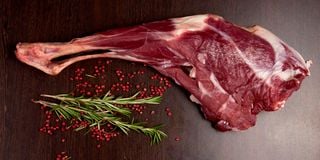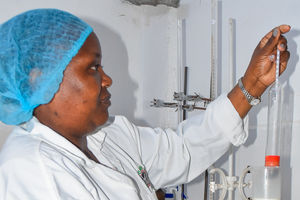Study: Meat from your butcher could make you resistant to antibiotics

Fresh goat meat from the farm.
What you need to know:
- Kenya recorded 8,500 deaths attributable to AMR and 37,300 deaths associated with AMR.
- The researchers found out that butchers have played a role in advancing AMR and potentially hindering proper inspection and enforcement of regulations.
Slaughterhouses in Kenya have become hotspots for antimicrobial resistance and the spread of zoonotic diseases.
The situation is made worse by butchers who turn away qualified meat inspectors whose duty is to ensure every meat people eat is certified.
This is according to researchers who sought to understand how slaughterhouses advance antimicrobial resistance leading to the spread of diseases from animals to human beings (zoonotic diseases) in rural areas.
The study was published by the Centres for Diseases Control and Prevention and conducted by different scientists including those from Kenya.
The World Health Organisation explains that antimicrobial resistance (AMR) happens when viruses, fungi, bacteria and parasites change over a period of time, and stop responding to medication. This makes it harder to treat resultant diseases or infections and increases the risk of disease spread, severe illness and death.
The scientists investigated how this affects health and food safety, and so they spoke to slaughterhouse workers, county and sub-county veterinary officers as well as meat inspectors in Busia, Bungoma and Kakamega counties.
The researchers found out that butchers have played a role in advancing AMR and potentially hindering proper inspection and enforcement of regulations.
“You will find a carcass has already been prepared, you come to inspect and find the injection site is full of drugs, when you tell this person (butchers), that this animal is not fit, you will be looking for trouble,” indicates a quote from a focused group published in a recent study done in Kenya.
While it is recognised by law that animals (cows, chickens, pigs) can only be slaughtered in a recognised slaughter facility registered under the Meat Control Act Cap 356 of Kenya, most people flaunt this.
Misuse drugs
The researchers also found out that some veterinarians misuse drugs by under-dosing or overdosing animals and prescribing diseases indiscriminately to unsuspecting farmers. This misuse is identified as a major driver of antimicrobial resistance.
However, some drivers were beyond their control, such as limited staffing, and lack of essential facilities such as access to clean water and perimeter fences, thus compromising biosecurity. Slaughterhouse workers also cited poor and indiscriminate disposal of slaughterhouse waste, which contaminates the surrounding environment.
“In workshops for slaughterhouse workers, participants recognised they should seek medical advice before purchasing drugs, but admitted to often self-medicating. The most popular antibiotic purchased for humans was amoxicillin and the most popular for livestock was oxytetracycline,” says the study.
“Hygiene, both personal and at the workplace, was recognised as a key element in dealing with resistance. However, the uncertainty and poor pay associated with slaughterhouse work did not enable workers to purchase the required clothing and equipment,” adds the study.
Dr Victor Yamo, Humane and Sustainable Agriculture Campaign Manager at the World Animal Protection who was not part of the study explains that when food animals are given antibiotics indiscriminately (self-prescription) we end up having antibiotic residues in the animal products (meat, milk, eggs) which ultimately end up in the food chain with a negative impact on the health of the consumer.
He explains that antibiotics are classified by the AWaRe system which stands for; Access, Watch and Reserve, based on their level of criticalness in use.
The classification is intended as a tool for monitoring antibiotic consumption, defining targets and monitoring the effects of stewardship policies that aim to optimise antibiotic use and curb antimicrobial resistance, but self-prescription makes this difficult.
“Indiscriminate use of antibiotics on farm animals also selects resistant bacteria within the animals which can pass the resistant gene to human bacteria leading to antibiotic resistance infections that cannot be treated using the products administered to the animal,” he explains.
“Meat inspection starts before the animal is slaughtered (Ante mortem inspection) where animals with signs of disease, wounds, injuries or dead ones are removed as they could contaminate the clean (wholesome) meats during the slaughter process. This inspection can only be done by an expert meat inspector. Once the animal is slaughtered the post-mortem examination can be done and the whole carcass can be condemned or certain areas or organs condemned based on the visual examination by the meat inspector,” says Dr Yamo.
He adds that manure from production systems where there is undiscerning use of antibiotics carries antibiotic residues and antibiotic-resistant genes which ultimately contaminates the environment when used on our farms spreading the contamination to the plant food that we grow.
“When it rains like now the rain washes the contamination into the streams thereby contaminating the fish and community water sources,” he tells the Nation.
This study advances one that was conducted in 2019 which shows that Kenyan poultry farmers contribute to antibiotic resistance in poultry production through failure to consult veterinarians, resulting in self-prescription of antibiotics.
While some farmers used antibiotics for treating diseases, some bought them to prevent diseases in day-old chicks and mature birds, while others bought them to improve egg production.
“Fluoroquinolone, Aminoglycoside and tetracycline were the most popular, marketed to enhance egg production of layers. Together with Polymixin and macrolides, they sold relatively quickly. Farmers said that they associate the containers' yellow colour and a picture of an egg with increased production,” said the study.
Farm animals
“Farmers must learn to consult veterinarians when animals are sick so that the correct diagnosis is made and the appropriate treatment administered. Antibiotics are not the only treatment available. We estimate that 40 to 80 per cent of the antibiotics currently being used on farm animals is unnecessary especially if we adhere to high welfare production standards,” explains Dr Yamo.
According to Global Research on Antimicrobial Resistance, Kenya recorded 8,500 deaths attributable to AMR and 37,300 deaths associated with AMR.
The World Organisation for Animal Health, which has been tracking antimicrobial use in animals since 2015 says antimicrobial use in animals declined globally by 13 per cent in three years. Europe, Asia, the Far East and Oceania experienced a decline, while Africa recorded a 45 per cent increase.
To reduce this percentage, Dr Yamo says that the management of veterinary products (including antibiotics) must remain in the hands of the competent authorities (veterinarians) who are trained on drug interactions within animals.
“Ensuring that at the production level, we are having high welfare production systems. These are systems that recognize the sentience of farm animals and cater for the five animal welfare freedoms. That is why as an organisation we are pushing corporations to not only make animal welfare commitments but also commitments to use antibiotics. In most instances farmers use antibiotics to mask poor unhygienic production systems,” he explains.






